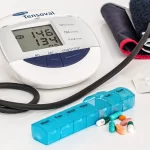Canagliflozin (Invokana) is the most potent of all the SGLT-2 inhibitors. It has the greatest A1C reduction compared to Farxiga (Dapagliflozin), Jardiance (Empagliflozin), and Steglatro (Ertugliflozin).
Canagliflozin is an SGLT-2 inhibitor that is a diabetic medication and helps in filtering out the extra glucose from the body by excreting it through the urine.
This drug is most effective if it is continued with a healthy diet and regular exercise.
| Brand Name | Invokana |
| Generic Name | Canagliflozin |
| Drug Class | SGLT2 inhibitors |
Who can use Canagliflozin (Invokana)?
Canagliflozin can be used:
- To improve glycemic control in adults with type 2 diabetes mellitus
- To lower the risk of CVD (cardiovascular disease)
- To reduce the risk of end-stage renal disease.
How to use Invokana?
Canagliflozin is available as a tablet that is taken once daily. It is preferred to take canagliflozin before meals.
The suggested starting dose is 100 mg/day, which can be increased to 300 mg if necessary.
Mechanism of Action of Canagliflozin:
Type 2 diabetes is a condition in which the body develops resistance to the hormone insulin, which is responsible for maintaining blood glucose levels.
This resistance develops over time and eventually leads to persistent high blood glucose levels that can lead to serious complications if not controlled on time.
Canagliflozin is a drug used to treat high blood glucose levels. It works by inhibiting the release of sodium-glucose cotransporter-2 from the kidneys.
SGLT-2 is mainly involved in the absorption of glucose from the urine, after which it is transferred back to the bloodstream.
By inhibiting SGLT-2, canagliflozin reduces glucose reabsorption in the renal tubules and decreases the renal threshold for glucose. This causes the excess glucose to be released in urine and thereby regulates its concentration in the blood
Canagliflozin is also helpful in regulating blood pressure because SGLT-2 is also responsible for the reabsorption of sodium.
As an SGLT-2 inhibitor, canagliflozin decreases the reabsorption of sodium, leading to a reduced sodium concentration in the blood and low blood pressure.
Pharmacokinetics and Pharmacodynamics of Invokana:
| Absorption | Readily absorbed in the GI tract |
| Bioavailability | Relative bioavailability of 65% |
| Peak concentration | achieved after 1 to 2 hours of administration |
| Half-life | 100 mg: 10.6 hours 300 mg: 13.1 hours |
| Metabolism | Metabolized via glucuronidation by the uridine diphosphate glucuronosyltransferase (UGT) enzymes UGT 1A9 and UGT 2B4. |
| Excretion | It is largely eliminated unchanged (41.5%) in the feces and as metabolites (30.5%) in the urine. |
Clinical Efficacy of Canagliflozin (Invokana):
Several studies have been conducted to assess the efficacy of Invokana.
According to a study, a 100 and 300mg dosage of canagliflozin significantly reduced HbA1c and fasting blood glucose levels.
It also reduced body weight and systolic blood pressure. However, the study also reported some adverse effects, such as UTIs and genital infections. [Ref]
Another study assessed the efficacy of canagliflozin in participants whose blood glucose levels were inadequately controlled by metformin.
The study results showed that canagliflozin after metformin monotherapy significantly improved glycemic control and aided in weight loss. However, this study also reported incidences of genital infections among women. [Ref]
A 52-week study compared the efficacy of canagliflozin with sitagliptin in participants previously using metformin.
The study reported that canagliflozin 300 mg was superior to 100mg of sitagliptin and reduced HbA1c, FPG, and mean body weight.
The study concluded that canagliflozin is a better treatment for improving glycemic control as compared to sitagliptin. [Ref]
The latest 2023 ADA Guidelines have approved the use of all SGLT-2 inhibitors for the treatment of diabetics with heart failure, however, only three SGLT-2 inhibitors have been recommended for the treatment of diabetic patients with ASCVD (atherosclerotic cardiovascular disease).
These include:
- Empagliflozin (Jardiance)
- Dapagliflozin (Farxiga)
- Canagliflozin (Invokana)
Canagliflozin in combination with other Diabetic Medications
Metformin is the most commonly prescribed medication for Type 2 diabetes. If your blood sugar remains high after taking metformin alone, you can combine it with canagliflozin.
This combination of metformin and canagliflozin has been shown to effectively lower blood sugar levels. In fact, canagliflozin and metformin are combined in single medications such as:
- Invokamet (canagliflozin/metformin)
- Invokamet XR (canagliflozin/metformin extended release).
Canagliflozin has also been investigated as a supplement to other medications such as sulfonylureas and insulin.
However, careful monitoring is required for these combination therapies, especially when combined with insulin. This is done to avoid a sudden drop in blood sugar levels.
This can also be adjusted with carbohydrate counting and adjusting the number of carbs in your daily meals.
Side effects of Canagliflozin (Invokana):
The most common side effects caused by Canagliflozin are:
- Genital Infections
- Urinary Tract Infections
- Hypoglycemia
- Weak/Fractured bones
- Constipation
- Decreased kidney function
- Nausea
- Increased LDL cholesterol
- Low blood pressure
- Ketoacidosis
Genital yeast infections and urinary tract infections are the most common side effects. Fournier’s gangrene is a life-threatening infection of the groin that is one of the emerging side effects associated with all SGLT-2 inhibitors.
In addition, volume depletion is commonly reported by patients using SGLT-2 Inhibitors, however, it can be the cause of renal failure if the person becomes dehydrated.
Who Cannot Take Canagliflozin (Invokana)?
Invokana should not be administered to patients with:
- Type 1 diabetes mellitus
- Diabetic ketoacidosis
- Patients with low GFR
- Patients on dialysis
Precautions and warnings:
- Blood volume should be assessed in patients with low blood pressure, patients using diuretics, or patients with impaired renal function
- If canagliflozin is administered to patients with renal impairment. Potassium levels should be checked to avoid hyperkalemia
- Proper adjustments should be made for people using exogenous insulin to avoid hypoglycemia
- LDL cholesterol levels should be regularly assessed in people using SGLT-2 Inhibitors.
- It is designated as a pregnancy category C drug and is not currently indicated to be used during pregnancy or lactation.





